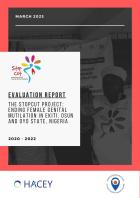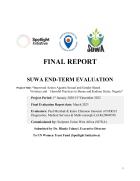1 - 4 of 4 Results
Date:
In Nigeria, HACEY Health Initiative implemented the three-year “The Stop Cut Project – Ending Female Genital Mutilation and Cutting in Southwest Nigeria”. The project aimed to promote effective implementation of laws and policies that protect women and girls from female genital mutilation and cutting (FGM/C), increase community engagement, and advocate for the abolition of FGM/C in three states by engaging stakeholders at the individual, family, societal and state levels. The final evaluation found that the project’s activities to raise awareness on laws and policies prosecuting FGM culprits were highly effective.
Date:
Scripture Union West Africa (SUWA) implemented the three-year project “Improved Action Against Sexual and Gender-Based Violence and Harmful Practices in Benue and Kaduna States” in Nigeria between 2020 and 2022 with the support of the UN Trust Fund. The project aimed to achieve its goals through school and community actions, creating positive social norms and building the capacity of the communities and institutions to tackle gender-based violence. The final evaluation found that these objectives were covered effectively and that the project activities were achieved, despite challenges posed by the COVID-19 pandemic and other crises.
Date:
The Sexual Offences Awareness & Victims Rehabilitation (SOAR) Initiative implemented the project “Mobilizing Communities to end Sexual Based Violence Against Girls in Dushe local District of Abuja Municipal Area Council” with support from the UN Trust Fund to End Violence against Women. The final evaluation found the project had improved girls’ experience of safety and support in schools and their communities.
Date:
The project Our Girls, Our Future: Building Synergy to End Violence Against Girls, implemented by the Tisunge Ana Athu Akazi Coalition and facilitated by Equality Now in Lusaka, Zambia from January 2010 to December 2012, was awarded a three-year grant by the UN Trust Fund to End Violence against Women. The final evaluation concluded that the model was valuable to share because it targeted perpetrators, victims, the community and organizations that could support the survivors of violence.

